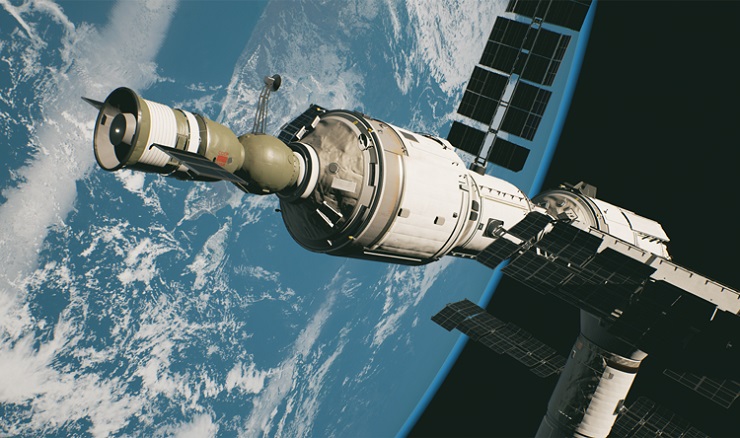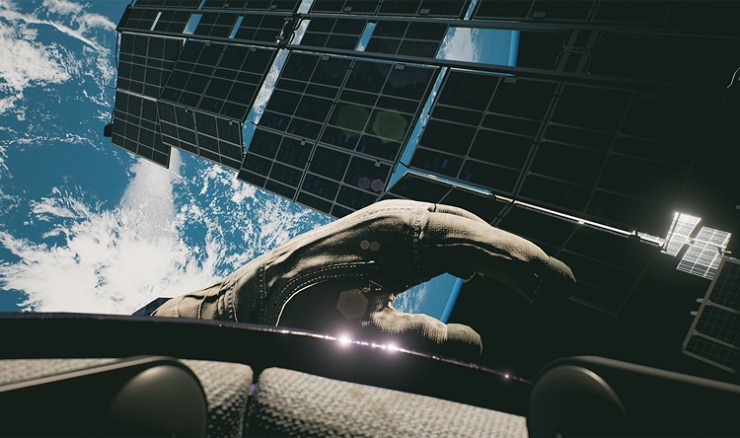Outreach is a zero-gravity first-person exploration game from London-based Pixel Spill that takes place aboard a Russian space station in the midst of the 1980s Cold War.
In this historical fiction game, players take control of an isolated Soviet Cosmonaut as they explore a seemingly empty Russian space station, inspired by Mir, after a communications blackout. Players find the vessel abandoned and quickly deteriorating, and it’s up to them to discover what happened to the crew and whether or not anything can be salvaged.
“Our artists spent three months of pre-production just sat down looking through blue prints,” says the game’s producer James Booth. “Because we wanted it to be as accurate as humanly possible, considering the size of the team. There’s only four of us.”
The game was inspired by movies like Hunt for Red October, which tell the story of the Cold War from the Soviet perspective. Other inspirations come from Cold War conspiracy theories, including “the lost cosmonaut” theory, which contends that prior to Juri Gagarin, there was actually a different first man in space, or several, but they all died during the mission.
“There’s a complete other perspective in the Cold War,” says Booth. “Both sides thought the other was the enemy.”
What sets Outreach apart from other first-person exploration games is its zero-G movement system both inside and outside the space station. While ostensibly a walking simulator, the developers call it a first-person floater. As historical fiction, it relies solely on the momentum players gain from pushing off objects.

“Unlike those games,” says Booth, “The movement system is actually a gameplay mechanic.”
And this mechanic is based on historical accuracy.
“There’s no jetpack,” says Booth. “There’s no magnetic boots. They didn’t exist in the 1980s.”
The other thing the team has put a lot of energy into is the narrative and voice acting. Voice actor Adam Harrington (Wolf Among Us, etc.), has taken a leading role in the project and directed his fellow voice actors. It’s an intimate story of one man who must survive the void of space in search for the truth about a ruined station.
In the demo I played at E3, I had to float around several station models and look for surviving crew members.
At first, the zero gravity controls are awkward and can quickly become disorienting. Players can propel themselves forward and stop themselves in mid-air. They can also look around and launch themselves in all directions within the station. If players propel themselves into a wall, however, they will spin wildly out of control until they stop themselves. Despite the physics, after a minute or two in weightless space, with 360 degrees of movement, I was able to bound around each module with ease. I found myself loving the freedom to turn upside down in the small spaces and continue on my merry way.
The voice of my Russian command officer crackled in my ear as we talked about the state of the station. Story objects like letters, photographs, and cassette tapes float throughout modules and players can grab these to uncover subplots within the larger story.
After a brief introduction to the station, I eventually had to make my way outside the station to reach an otherwise inaccessible module. This area turns the relaxing floating simulator into a tense experience. If players miss a zero-G jump from one hand-hold to another, they will float away from the safety of the station and die.

There are no models for the player’s hands when in space. This is due to Pixel Spill’s small team size, which consists of only four people. I didn’t even notice this omission until trying to navigate the outside of the station and carefully planning each jump between handles that lined the outside of the vessel. However, as soon as you are within the space station, hands are visible again.
Given the first-person perspective and low-key pacing, I had to ask about a VR version. Unfortunately, Booth says that they will not pursue a VR version because the ability for players to spin out of control would result in a lot of sick players. They tried it in VR, but they just couldn’t make it work.
“It would have a high discomfort level,” says Booth.
That said, Booth hints that the game might just work if launched with Oculus, but he’ll leave it to the community to experience that potential stomach ache. The developer is not advertising the game as VR-compatible, and aiming for a tight two- to three-hour narrative experience and will have an appropriate price. Outreach is the video game equivalent of the film Gravity. It focuses on innovative floating mechanics, a desolate atmosphere, a mysterious story, historical detail, and confronting the existential void of space.
Outreach hits Steam in the fall of 2017.
John Vanderhoef appears courtesy of the lovely people at GameCritics.com – this article may also be published there, so go check the site out!






